The street

 I didn't take as many photos as I should have that just showed what the streets looked like. What surprised us was how much they just looked like streets in any western city. At the left here is the view from the hotel balcony looking north along the coast. At the lower right is the tag end of the Number 1 Bathing Beach, where it peters out into a seaside boardwalk. In the center is the fountain outside the hotel entrance, and between the hotel and the sea is a busy four-lane road headed north, full of ordinary late-model cars like the ones you'd see in the U.S.
I didn't take as many photos as I should have that just showed what the streets looked like. What surprised us was how much they just looked like streets in any western city. At the left here is the view from the hotel balcony looking north along the coast. At the lower right is the tag end of the Number 1 Bathing Beach, where it peters out into a seaside boardwalk. In the center is the fountain outside the hotel entrance, and between the hotel and the sea is a busy four-lane road headed north, full of ordinary late-model cars like the ones you'd see in the U.S.
At the right is the view looking the other way. It's the same road; the beach is just to the left of the frame. The multicolored areas in the center are beds of colorful foliage plants (mostly Coleus). Near the lower right, parallel to the balcony railing in the lower right corner, you can see a multiflight staircase descending from street level. It leads to a large sunken area that affords pedestrian access to the huge underground parking garage (the one with the round paved Olympic plaza on top). The sunken area is lined with businesses, including a cinema and a Kentucky Fried Chicken. Cleverly, the staircase down is designed so that you have to climb up two steps before starting down; that ensures that walkers, bicyclists, and skateboarders crossing the plaza don't get distracted, look away, and take a header down the stairs.
The large curved bank of green windows in the background is a big department store cum shopping plaza, and the small pedestrian street that parallels its wall (below the tall arched windows) is lined with a shabby street market specializing in street food, including the inevitable squid (and many other invertebrates,mostly dried) on a stick. We walked that way each day back and forth between our hotel and the Huang Hai, where the meetings were held.
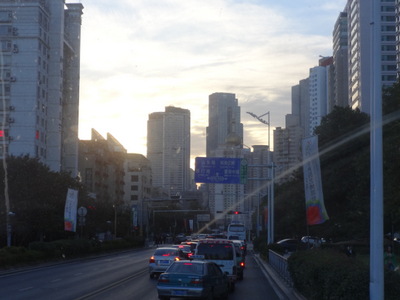
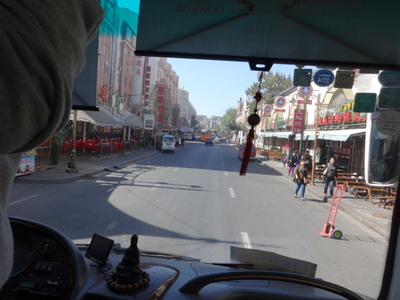 The rest of the photos in this section were taken from the bus during our 16 October tour.
At the left are the tall buildings of downtown Qingdao, again showing all-modern architecture and perfectly ordinary western-style traffic. Of the car makes, I can make out only Volkswagen and Chevrolet. The big blue sign, like all the other street-name signs we saw, gives the street names in both Chinese and western characters. The vertical green sign at its right-hand edge advertises the 2014 International Horticultural Exposition, which had been going on for months and closed just as we arrived. It was heavily signposted all over town and must have been a very big deal.
The rest of the photos in this section were taken from the bus during our 16 October tour.
At the left are the tall buildings of downtown Qingdao, again showing all-modern architecture and perfectly ordinary western-style traffic. Of the car makes, I can make out only Volkswagen and Chevrolet. The big blue sign, like all the other street-name signs we saw, gives the street names in both Chinese and western characters. The vertical green sign at its right-hand edge advertises the 2014 International Horticultural Exposition, which had been going on for months and closed just as we arrived. It was heavily signposted all over town and must have been a very big deal.
At the right is a popular shopping and dining street near the Tsingtao brewery. Lots of neon and sidewalk tables, and nearly all the signs are topped by the Tsingtao logo. Note the virtually total absence of bicycles.
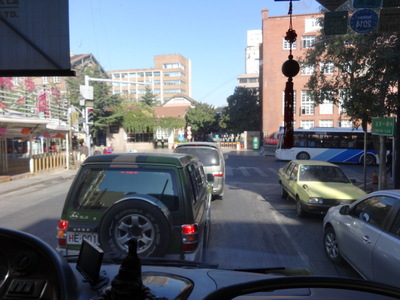
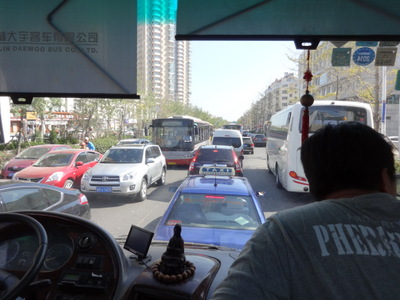 As we headed out of town of our way to Laoshan, the buildings became lower, and street plantings more common. In this photo, I can make out the logos of Mercedes, Toyota, and Honda. In the photo to the right, I can make out Volkswagen and something I don't recognize. Our bus (like most others I saw) was a Korean Daewoo.
As we headed out of town of our way to Laoshan, the buildings became lower, and street plantings more common. In this photo, I can make out the logos of Mercedes, Toyota, and Honda. In the photo to the right, I can make out Volkswagen and something I don't recognize. Our bus (like most others I saw) was a Korean Daewoo.
In places, the traffic was much more congested than others, but it was always multi-lane and fairly high-speed.
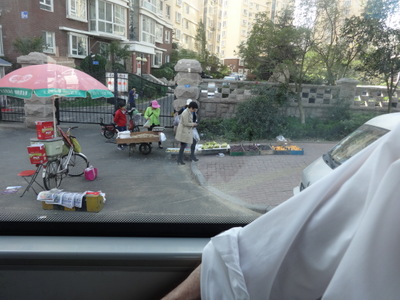
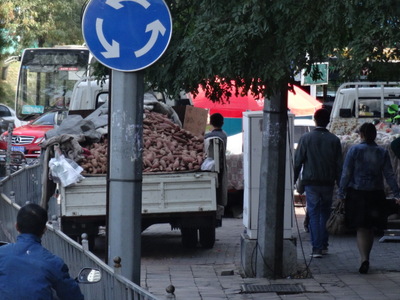 Here, on the left, are a couple of produce stands selling fruit (including jujubes) and peanuts. At the left-hand side is one of the few bicycles we saw in the city, with a cooler mounted on the back. Behind the cluster of people in the center, though, is a shiny red and black motor scooter. The flat gray object balanced on the corner of the peanut barrow (in front of the lady with the bright pink hat) is a digital produce scale.
Here, on the left, are a couple of produce stands selling fruit (including jujubes) and peanuts. At the left-hand side is one of the few bicycles we saw in the city, with a cooler mounted on the back. Behind the cluster of people in the center, though, is a shiny red and black motor scooter. The flat gray object balanced on the corner of the peanut barrow (in front of the lady with the bright pink hat) is a digital produce scale.
In the photo on the right is a truck parked on the sidewalk from which a vendor is selling sweet potatoes. Note the hood of the bright red Mercedes visible behind it. I couldn't make out what the truck parked on the right-hand side of the sidewalk was selling.
The Beach
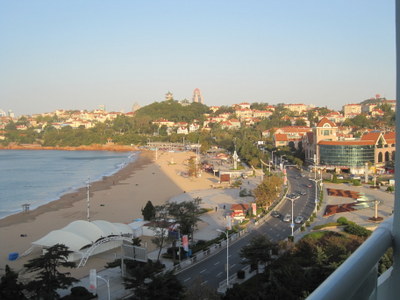
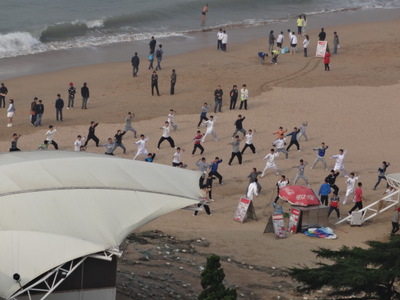 The beach , right below our hotel windows, was endlessly fascinating. The photo at the right shows about the density of people on it during the busiest day we were there, a Sunday. The photo at the left must have been taken early in the morning or late in the afternoon, as the beach is almost deserted.
The beach , right below our hotel windows, was endlessly fascinating. The photo at the right shows about the density of people on it during the busiest day we were there, a Sunday. The photo at the left must have been taken early in the morning or late in the afternoon, as the beach is almost deserted.
In the photo on the right, note the young men standing in neat rows holding a pose. They might have been doing tai chi, but they seemed to hold the same pose for long periods—10 minutes at a time—until some of them couldn't keep it up. Then they'd strike a different pose and hold that for a long time. Whoever was leading the exercise was hidden by the canvas awning. On the ground below the awning, long rows of what looked like fish nets with floats were piled, but we never saw them moved during the week we were there.
In the photo at the left, the area just beyond the water is the beginning of the old German concession.
The waters off the beach were divided into long rectangles (short ends against the beach) by lines of floats, and swimmers were apparently expected to confine themselves to the insides of those rectangles, although we occasionally saw them venture beyond the seaward ends of them. Beside the rectangles was an unbounded area where, on the busy Sunday, a small group of guys were offering jet-ski rides for children. Each child would be fitted with a life vest, then a guy in waders would carry the kid out and put him on the jet ski, one child behind the driver and one in front. They they would zoom off to make a few big loops before coming back. Up to three jet-skis were in use at a time. Just once, I saw somebody parasailing behind a boat, dangling below a colorful round parachute.
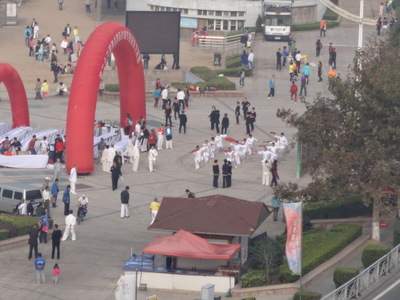
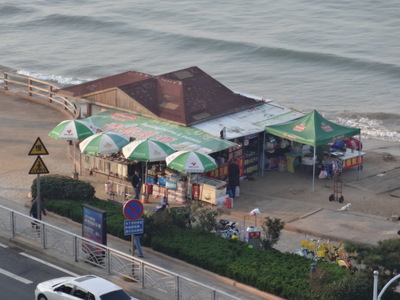 On the busy Sunday, preparations were being made for some kind of ceremony on the beach, featuring these red inflatable arches, a few dance groups, rows of tables with chairs facing the water, and an elaborate sand carving/sculpture. Many people were working on the sand sculpture, which seemed to be some sort of framed inscription, but they clustered tightly around it until after we left for the day, so I never got a good look at it. By the time we got back, it was all over, the arches and tables were gone, and the tide had effaced the sand sculpture. We speculate that it was a wedding, or maybe an awards ceremony having to do with the dance competition of one of the many meetings and conventions going on nearby.
On the busy Sunday, preparations were being made for some kind of ceremony on the beach, featuring these red inflatable arches, a few dance groups, rows of tables with chairs facing the water, and an elaborate sand carving/sculpture. Many people were working on the sand sculpture, which seemed to be some sort of framed inscription, but they clustered tightly around it until after we left for the day, so I never got a good look at it. By the time we got back, it was all over, the arches and tables were gone, and the tide had effaced the sand sculpture. We speculate that it was a wedding, or maybe an awards ceremony having to do with the dance competition of one of the many meetings and conventions going on nearby.
The photo at the right shows one of the larger and more elaborate souvenir stands on the beach. It also sold food (squid on a stick, whole ears of corn, etc.), popsicles, bottled water, Red Bull, beach toys (tiny plastic buckets and spades were ubiquitous), and broad-brimmed hats.
On the busy Sunday, individuals were also peddling beach food from little push carts, and small groups were apparently renting out beach chairs and umbrellas.
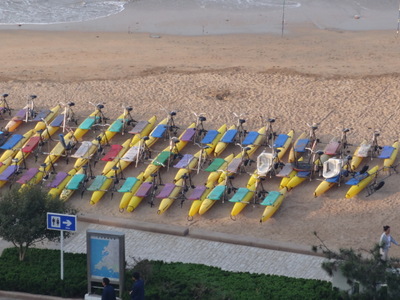
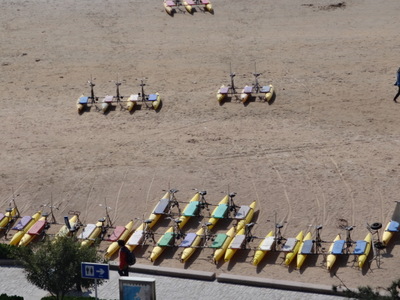 Near our end of the beach were these serried ranks of peddle-driven catamarans. A bicycle was mounted between each pair of floats, so the passengers sat on the bike and peddled to drive a little propeller at the rear.
Near our end of the beach were these serried ranks of peddle-driven catamarans. A bicycle was mounted between each pair of floats, so the passengers sat on the bike and peddled to drive a little propeller at the rear.
Only on the busy Sunday, when a few of them were actually put into use, could I see that they were not just pairs of floats—they came in several sizes from two floats with one bicycle to family-sized models with four bicycles and five floats abreast. Presumably they had rudders of some kind, but I don't know whether they were controlled by the handlebars.
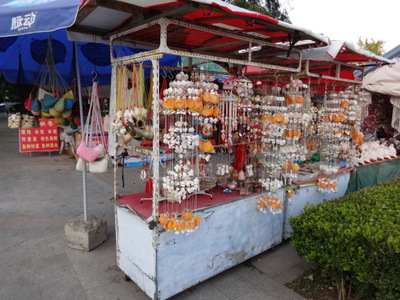 Here's a closer view of one of the many, many souvenir stands scattered around the area to a distance of several blocks from the beach. The big seller was apparently stuff made of seashells—mobiles, wind chimes, picture frames, necklaces and bracelets, other jewelry, animals (real and imaginary)—and seashells themselves; I saw rows and rows of lovely big conchs. No idea whether they were local. This place also sold hats and purses made of straw or beads, horns made from shells or from real cow horns, china and wooden figurines, and the ubiquitous buckets, spades, water, and soft drinks. I was tempted to buy a souvenire shell but was afraid the USDA would take a dim view of it when we came back through customs.
Here's a closer view of one of the many, many souvenir stands scattered around the area to a distance of several blocks from the beach. The big seller was apparently stuff made of seashells—mobiles, wind chimes, picture frames, necklaces and bracelets, other jewelry, animals (real and imaginary)—and seashells themselves; I saw rows and rows of lovely big conchs. No idea whether they were local. This place also sold hats and purses made of straw or beads, horns made from shells or from real cow horns, china and wooden figurines, and the ubiquitous buckets, spades, water, and soft drinks. I was tempted to buy a souvenire shell but was afraid the USDA would take a dim view of it when we came back through customs.
One morning, I heard what sounded like firecrackers under my windows, so I pulled out the binoculars and had a look. It turned out to be men playing with tops! (That's a group of them—one guy in a yellow shirt and two in dark shirts—partly hidden by a roof in the bottom center of the photo showing the inflatable red arches.) They were standing around singly or in groups on the paved areas between the road and the beach. Each one had a whip made of a short stick, maybe 30 inches long, with a string of some sort, of about the same lengh, on the end, and they were spinning shiny metal tops, each about the size and shape of a coffee can, by forcefully flailing them with the whips; each whack made a loud cracking noise. Some were following and spinning their own individual tops; others were in groups, taking turns whacking a shared top that wandered around among them. I never figured out whether the game had an object other than to keep the tops spinning as long as possible.
On another day, several radio-controlled model airplanes (including a fighter jet and a biplane) were swooping around over the beach. I saw them (or perhaps different ones) again later, over a large open field beyond the Olympic plaza.
Kites were also popular, mainly among adults, although I saw a few children with them, but they tended to be flown from the Olympic plaza more often than from the beach. You could buy kites at some of the souvenir stands. I never saw any evidence of kite contests, trying to cut each other's strings and whatnot; the flyers were just peaceably flying their kites and minding their own business.
previous entry
List of Entries
next entry

 I didn't take as many photos as I should have that just showed what the streets looked like. What surprised us was how much they just looked like streets in any western city. At the left here is the view from the hotel balcony looking north along the coast. At the lower right is the tag end of the Number 1 Bathing Beach, where it peters out into a seaside boardwalk. In the center is the fountain outside the hotel entrance, and between the hotel and the sea is a busy four-lane road headed north, full of ordinary late-model cars like the ones you'd see in the U.S.
I didn't take as many photos as I should have that just showed what the streets looked like. What surprised us was how much they just looked like streets in any western city. At the left here is the view from the hotel balcony looking north along the coast. At the lower right is the tag end of the Number 1 Bathing Beach, where it peters out into a seaside boardwalk. In the center is the fountain outside the hotel entrance, and between the hotel and the sea is a busy four-lane road headed north, full of ordinary late-model cars like the ones you'd see in the U.S.
 The rest of the photos in this section were taken from the bus during our 16 October tour.
At the left are the tall buildings of downtown Qingdao, again showing all-modern architecture and perfectly ordinary western-style traffic. Of the car makes, I can make out only Volkswagen and Chevrolet. The big blue sign, like all the other street-name signs we saw, gives the street names in both Chinese and western characters. The vertical green sign at its right-hand edge advertises the 2014 International Horticultural Exposition, which had been going on for months and closed just as we arrived. It was heavily signposted all over town and must have been a very big deal.
The rest of the photos in this section were taken from the bus during our 16 October tour.
At the left are the tall buildings of downtown Qingdao, again showing all-modern architecture and perfectly ordinary western-style traffic. Of the car makes, I can make out only Volkswagen and Chevrolet. The big blue sign, like all the other street-name signs we saw, gives the street names in both Chinese and western characters. The vertical green sign at its right-hand edge advertises the 2014 International Horticultural Exposition, which had been going on for months and closed just as we arrived. It was heavily signposted all over town and must have been a very big deal.
 As we headed out of town of our way to Laoshan, the buildings became lower, and street plantings more common. In this photo, I can make out the logos of Mercedes, Toyota, and Honda. In the photo to the right, I can make out Volkswagen and something I don't recognize. Our bus (like most others I saw) was a Korean Daewoo.
As we headed out of town of our way to Laoshan, the buildings became lower, and street plantings more common. In this photo, I can make out the logos of Mercedes, Toyota, and Honda. In the photo to the right, I can make out Volkswagen and something I don't recognize. Our bus (like most others I saw) was a Korean Daewoo.
 Here, on the left, are a couple of produce stands selling fruit (including jujubes) and peanuts. At the left-hand side is one of the few bicycles we saw in the city, with a cooler mounted on the back. Behind the cluster of people in the center, though, is a shiny red and black motor scooter. The flat gray object balanced on the corner of the peanut barrow (in front of the lady with the bright pink hat) is a digital produce scale.
Here, on the left, are a couple of produce stands selling fruit (including jujubes) and peanuts. At the left-hand side is one of the few bicycles we saw in the city, with a cooler mounted on the back. Behind the cluster of people in the center, though, is a shiny red and black motor scooter. The flat gray object balanced on the corner of the peanut barrow (in front of the lady with the bright pink hat) is a digital produce scale.
 The beach , right below our hotel windows, was endlessly fascinating. The photo at the right shows about the density of people on it during the busiest day we were there, a Sunday. The photo at the left must have been taken early in the morning or late in the afternoon, as the beach is almost deserted.
The beach , right below our hotel windows, was endlessly fascinating. The photo at the right shows about the density of people on it during the busiest day we were there, a Sunday. The photo at the left must have been taken early in the morning or late in the afternoon, as the beach is almost deserted.
 On the busy Sunday, preparations were being made for some kind of ceremony on the beach, featuring these red inflatable arches, a few dance groups, rows of tables with chairs facing the water, and an elaborate sand carving/sculpture. Many people were working on the sand sculpture, which seemed to be some sort of framed inscription, but they clustered tightly around it until after we left for the day, so I never got a good look at it. By the time we got back, it was all over, the arches and tables were gone, and the tide had effaced the sand sculpture. We speculate that it was a wedding, or maybe an awards ceremony having to do with the dance competition of one of the many meetings and conventions going on nearby.
On the busy Sunday, preparations were being made for some kind of ceremony on the beach, featuring these red inflatable arches, a few dance groups, rows of tables with chairs facing the water, and an elaborate sand carving/sculpture. Many people were working on the sand sculpture, which seemed to be some sort of framed inscription, but they clustered tightly around it until after we left for the day, so I never got a good look at it. By the time we got back, it was all over, the arches and tables were gone, and the tide had effaced the sand sculpture. We speculate that it was a wedding, or maybe an awards ceremony having to do with the dance competition of one of the many meetings and conventions going on nearby.
 Near our end of the beach were these serried ranks of peddle-driven catamarans. A bicycle was mounted between each pair of floats, so the passengers sat on the bike and peddled to drive a little propeller at the rear.
Near our end of the beach were these serried ranks of peddle-driven catamarans. A bicycle was mounted between each pair of floats, so the passengers sat on the bike and peddled to drive a little propeller at the rear. Here's a closer view of one of the many, many souvenir stands scattered around the area to a distance of several blocks from the beach. The big seller was apparently stuff made of seashells—mobiles, wind chimes, picture frames, necklaces and bracelets, other jewelry, animals (real and imaginary)—and seashells themselves; I saw rows and rows of lovely big conchs. No idea whether they were local. This place also sold hats and purses made of straw or beads, horns made from shells or from real cow horns, china and wooden figurines, and the ubiquitous buckets, spades, water, and soft drinks. I was tempted to buy a souvenire shell but was afraid the USDA would take a dim view of it when we came back through customs.
Here's a closer view of one of the many, many souvenir stands scattered around the area to a distance of several blocks from the beach. The big seller was apparently stuff made of seashells—mobiles, wind chimes, picture frames, necklaces and bracelets, other jewelry, animals (real and imaginary)—and seashells themselves; I saw rows and rows of lovely big conchs. No idea whether they were local. This place also sold hats and purses made of straw or beads, horns made from shells or from real cow horns, china and wooden figurines, and the ubiquitous buckets, spades, water, and soft drinks. I was tempted to buy a souvenire shell but was afraid the USDA would take a dim view of it when we came back through customs.